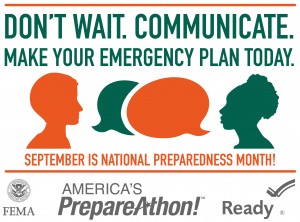All throughout the month of September the Federal Emergency Management Agency is promoting National Preparedness Month in an effort to help mitigate the impact of potential disasters. The Federal Emergency Management Agency (FEMA) is asking all of us to take action immediately by making a plan for your business, your community, your family, and for your pets. FEMA and other government agencies have a number of resources available to us, including helpful materials on their website, to help you plan how to effectively communicate and stay safe during disasters.
Depending on what region of the country you live in, disaster preparedness needs can vary from one area to the next. For example, some areas are more prone to flooding than they are to earthquakes, so it is important to be knowledgeable about the potential disasters that may affect where you live. Tornados, hurricanes, earthquakes, fires and other disasters are often unpredictable. No matter where you live, there are a few steps that should be taken to help you and be prepared for emergency situations.
STEP 1: Make a Kit
The first step is to prepare a supply kit that has the essential items for the first 72 hours after an emergency. This includes water, non-perishable food, batteries, blankets, and first aid supplies. It’s also a good idea to write down the phone numbers and addresses of your family and store it inside of your emergency kit. You may not be able to search for it online or on your phone during a crisis. Don’t forget to stash food for your pets as well! Finally, be sure to store the kit in a location where everyone can find it.
STEP 2: Make a Plan
Once you’ve assembled your kit, you should discuss the plan of action for after an emergency. If you needed to, would you know how to shut off gas, electricity and water? How will you communicate with those closest to you? Texting is easier than calling in the moments following a disaster, and are a great way to let others know that you’re safe. Local phone lines will likely be overwhelmed in the moments following a disaster…do you have an out of town relative that you can all reach out to and communicate with should you be unable to reach one another locally?
You also need to discuss places to meet. Remember… different disasters may require you to go to different places, so it’s a good idea to have a few planned spots to head for, both in and out of your immediate neighborhood.
STEP 3: Make Sure You’re Informed
Which types of emergencies are most likely to occur in your area? Do you know how to respond to each one? Take a few minutes to review the potential threats that occur with each possible disaster. Be sure that you know what to do in the event of earthquakes, high winds, floods, and severe weather.
Do you know how your community gets the word out about potential dangers? Some local governments text alerts to local residents, others use sirens…would you know what the siren meant if you heard it?
Do you know which local stations broadcast information, designated shelters and evacuation instructions for your region? The best time to seek out this information is before you need it. Commit to finding this information now, and sharing it with your family and friends.
Some disasters are unavoidable but taking these steps can help soften the blow when one does strike. By being proactive, one can minimize loss in both their personal and professional life. For more information, check out our article on Automatic vs. Manual transfer switches, which illustrates potential threats to a business in the event of a power outage. Loss of power can lead to spoiled product, lost wages and upset customers. Prevent it if you can!
For more information on how you can be better prepared visit http://www.ready.gov/september and click here to learn more about our Emergency Power line of products.
